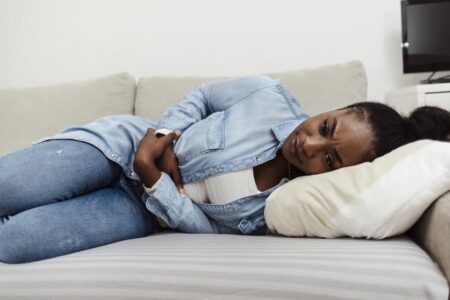Dr. Caitlin Morin, OB/GYN at Virginia Physicians for Women, discusses how symptoms and treatment options of bacterial vaginosis and yeast infections differ and shares tips for preventing both.
Ahhh! Summer is here. You’re packing your beach bag, dusting off your favorite sundress, and grabbing a delicious ice cold beverage. All of a sudden…what’s that itch? What’s that odor? Something is not right “down there!”
Vaginal infections can be both uncomfortable and frustrating. Two common vaginal infections are yeast infections (Candidiasis) and bacterial vaginosis or “BV.” But what’s the difference between bacterial vaginosis vs. yeast infection? How do I know if I have a yeast infection or BV? Why do we get these vaginal infections? What can we do to treat and also prevent them? Let’s dive in!

First of all, what is normal when it comes to vaginal discharge?
Everyone has vaginal discharge! The vagina is a very complex environment of bacteria and other organisms. A healthy vagina is rich in “good” bacteria called lactobacilli. These bacteria work to prevent other organisms from overgrowing.
It is NORMAL to have a mild amount of clear-to-white discharge that may have an earthy odor. This discharge may look yellow when it dries on underwear. Around the time of ovulation (usually about 2 weeks before your period), there may be a noticeable increase in discharge for a few days.
What causes a yeast infection vs. BV?
The organisms that cause yeast and BV live in the vagina normally and are usually kept at healthy levels by the “good” bacteria (lactobacilli) that also lives there. The problem occurs when harmful bacteria, yeast, or other organisms grow uncontrolled. This imbalance is what leads to vaginal infections.
How common are yeast infections and BV?
Yeast and BV infections are very common. Approximately 70% of women will have at least one yeast infection in their lifetime and 30% of women will experience a BV infection.
What’s the difference between bacterial vaginosis vs. yeast infection?
How do you know if you have BV or a yeast infection? Let’s explore the differences in BV symptoms vs. yeast infection symptoms, and then we’ll take a look at what causes each infection.
Symptoms of a Yeast Infection vs. BV
Symptoms of a yeast infection include thick discharge, vaginal soreness, irritation, itching, redness, swelling, burning and pain.
BV symptoms range from increased discharge, odor, or irritation.
Does BV itch like a yeast infection? Yes, both infections can come with itching and irritation. However, there are some major differences between BV and yeast infection discharge. The discharge from BV is usually thinner, with a distinctive fishy odor and often a gray, yellow or even greenish color. Yeast infection discharge is generally white, thicker and clumpier (think cottage cheese consistency) and usually does not have an odor.
It’s important to talk to your provider if you are experiencing a gynecological problem and think you may have either of these vaginal infections. Everyone experiences vaginal infections differently, so it can be difficult to tell if you have BV or a yeast infection based on your symptoms alone. I cannot overemphasize how important it is to be tested in order to correctly diagnose what type of infection is causing your symptoms, as treatment for each infection differs.
Causes of a Yeast Infection vs. BV
Yeast can cause problems when it evades the vagina’s normal defense mechanisms and begins to overgrow. This overgrowth of yeast is what can cause an inflammatory reaction. It can occur for a variety of reasons, including:
- A weakened microbiome (decreased “good” bacteria)
- High sugar levels in the urine (often the case with women who have untreated, undiagnosed or poorly controlled diabetes)
- Taking medications or have medical conditions that suppress the immune system
- ”Trauma” to the vulvar/vaginal tissue from scratching, friction or sex
Bacterial Vaginosis occurs when there is a reduction in “good” bacteria, which leads to an overgrowth of “harmful” bacteria. BV infections can occur due to:
- Environmental exposures: Spermicide, antibiotics, vaginal products, douching, and cigarette smoking all decrease the good bacteria and increase the likelihood of getting BV.
- Menstrual cycles: Our good bacteria often binds to red blood cells; thus, levels of good bacteria decrease significantly right after a menstrual cycle. Blood and bleeding can also change the pH of the vagina, which provides more nutrients for “harmful” bacteria to grow.
- Sex: The semen released by ejaculation can temporarily cause elevations in vaginal pH, which, similar to blood, can help “harmful” bacteria grow. Additionally, sexual partners can carry different bacteria that can be transmitted to the delicate vaginal environment and disrupt its balance. Condoms can protect against BV, especially if BV infections seem to recur after intercourse. Although BV is not a sexually transmitted infection itself, it can increase the chances of acquiring an STI such as gonorrhea, chlamydia or HIV.
How are yeast infections and BV treated?
As mentioned, yeast infections and BV have very different courses of treatment. Yeast infections are typically treated with antifungal medications, whereas BV is typically treated with antibiotics. Once you have been tested and your provider has diagnosed whether you have a yeast infection or BV, you can begin treatment.
Yeast Infection Treatment
Yeast infections are treated with a class of drugs called “azoles.” Azoles are creams and suppositories are available over-the-counter (Monistat) and come in one-, three- and seven-day options. The creams can often be soothing for symptoms, but if the vulva/vagina is very inflamed, applying any product on the area can cause pain and burning.
A single-dose oral medication called fluconazole (Diflucan) is also available for yeast infection treatment with a prescription. The medication works for 72 hours. Sometimes a second dose of the medication is recommended after 72 hours if symptoms are still present. Giving a second dose sooner is not necessary. It can take a full week for all of the inflammation and symptoms to subside.
BV Treatment
BV can be treated with antibiotics that work on killing the harmful bacteria. There are a few options for treatment:
- An antibiotic pill called metronidazole can be taken twice daily for 7 days. Common side effects include GI upset and nausea. Some patients may experience a serious reaction (vomiting) if this antibiotic is taken with alcohol, so it is recommended to avoid alcohol during treatment.
- An antibiotic vaginal gel can be applied intravaginally, nightly for 7 days. This medication can produce a clumpy discharge that may be confused with yeast, although the actual risk for yeast is low. Contact your provider and get tested if you think you may have a yeast infection.
What’s the skinny on boric acid suppositories?
In specific situations, boric acid may be an appropriate treatment for either of these vaginal infections. Boric acid has two uses:
- It can treat specific types of yeast that are known to be resistant to commonly prescribed anti-yeast medications.
- It can treat recurrent bacterial vaginosis suspected to be caused by “biofilm.” Biofilms coat bacteria and make them resistant to antibiotics and regular treatment.
Boric acid can be irritating to the vaginal tissue, so always talk to your healthcare provider before starting boric acid supplements to make sure this is the right treatment for you. Boric acid can be deadly if ingested, so make sure you store it away from children/pets. You should not have receptive oral sex within 24 hours of using boric acid supplements.
Susceptibility to Vaginal Infections During Pregnancy
During pregnancy, lots of changes occur to the cervix, vagina and vulva– even as early as the first few weeks. Most women will notice they produce more discharge when they are pregnant. This is normal!
Pregnant women are at an increased risk for yeast infections and bacterial vaginosis. This may be due to the higher levels of estrogen and progesterone that your body produces during this time, or the mild immunosuppression that normally occurs with pregnancy.
Topical azoles (creams and suppositories) are the preferred treatment of yeast infections in pregnancy, as there is currently some conflicting data about the safety of oral azoles during pregnancy. It is safe to treat BV with antibiotics during pregnancy.
Make sure to talk to your provider asap if you are pregnant and think you may have a vaginal infection.
How to prevent yeast infections and BV
You’re probably wondering, is there anything I can do to avoid getting these infections? There are lots of vaginal products at the grocery store and I’m confused…
The answer is yes! There are little things you can do to maintain a healthy vulvar/vaginal environment and reduce your risk of getting an infection.
- Avoid trapping moisture and causing friction to the vulva
You can do this by:
- Avoiding tight-fitting clothing
- Wearing underwear made of breathable materials (cotton) that fits well (i.e. does not cause chaffing)
- Wearing loose-fitting boxers” or pajamas or no underwear at night
- Changing out of wet swimsuits or sweaty workout clothes as soon as possible
- Avoiding using only pads and pantyliners when you have your period. These products have plastic backing and keep warmth and moisture close to the body. Consider trying “period underwear.”
2. Avoid irritants and vaginal “cleaning.”
Your vagina does its own “self-cleaning,” and vaginal cleaning or douching can disrupt this process. Pass on “feminine hygiene” sprays, wipes, washes or soaps (e.g. Summer’s Eve, Vagisil, etc). I promise your vagina does not need to smell like Tropical Breeze in order to be healthy. These products contain tons of irritants and have no medical benefits. Even the “sensitive skin” products contain irritants. Use water only or a gentle facial cleanser (Cereve or Cetaphil) to clean the vulva (area outside the vagina). Do not douche.
3. Use a laundry detergent that is in the “free and clear” category.
Certain detergents can irritate the vagina. Avoid fabric softeners and dryer sheets – use dryer balls instead.
4. Maintain blood sugar levels.
Yeast loves to feast on sugar! If you are diabetic, make sure you are maintaining normal blood sugar levels. If you have recurrent yeast infections, ask your doctor if you should be tested for diabetes.
5. Avoid antibiotics unless necessary.
Antibiotics can wipe out your “good” bacteria, allowing other organisms to overgrow and cause infections. That said, if you need antibiotics, you need them. You should never stop your antibiotics prematurely even if you think you have a vaginal infection.
Your provider can help you clear an infection quickly and safely.
Most importantly, if you think you have a vaginal infection, talk to your provider.
Taking medications for an incorrect self-diagnosis or in a prolonged fashion can lead to vulvar reactions and inflammatory skin conditions, which make symptoms worse. It is essential to properly diagnose the right infection, if any, so that we can properly treat you and help you get back to enjoying the rest of your summer!

To schedule an appointment with a VPFW provider, you can call us at 804-570-2001 or set an appointment online.
About Caitlin Morin, M.D.
Dr. Caitlin Morin is an OB/GYN at Virginia Physicians for Women. She sees patients at VPFW’s St. Francis and Prince George offices and delivers babies at St. Francis Medical Center. She lives in the Fan with her fiancé.







